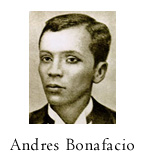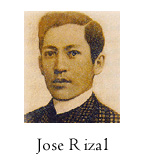The
Katipunan
The Katipunan (meaning "Association")
planned and initiated the Philippine Revolution. It
was founded in Tondo, Manila, by Andres Bonifacio and
a few other fellow urban workers on July 7, 1892. Its
full Tagalog name is Kataastaasan Kagalang-galang
na Katipunan nang manga Anak ng Bayan (Highest and
Most Venerated Association of the Sons and Daughters
of the Land). From its inception, Katipunan was forged
by blood, with all its members enacting the traditional
blood compact and signing their names with their own
blood. The foremost goal of the Katipunan was political,
the separation of the Philippines from Spain. Its members
also recognized and performed a civic duty which was
mutual assistance and the defense of the poor and the
oppressed.
 The
Katipunan was steered by Bonifacio, who became known
as the Supremo (Supreme) of the Katipunan, and
he was ably supported by Emilio
Jacinto, who emerged as the "Brains of the
Katipunan." Philippine historians regard Bonifacio
as the "Great Plebeian" because he came from
a poor family in Tondo and worked as a warehouse clerk.
Despite his poverty, Bonifacio was able to educate himself
by reading the works of Rizal
and the French revolutionists. The
Katipunan was steered by Bonifacio, who became known
as the Supremo (Supreme) of the Katipunan, and
he was ably supported by Emilio
Jacinto, who emerged as the "Brains of the
Katipunan." Philippine historians regard Bonifacio
as the "Great Plebeian" because he came from
a poor family in Tondo and worked as a warehouse clerk.
Despite his poverty, Bonifacio was able to educate himself
by reading the works of Rizal
and the French revolutionists.
Because of its brotherhood appeal, Katipunan was swift
in recruiting members from the peasants and the working
class. Philippine historian Reynaldo Ileto points out
that the Katipunan belonged to a long tradition of social
movements in Philippine history which fortunately have
been disparaged and branded by authorities and the elite
as "illicit associations" and its members
as bandits. Like most of these popular movements, the
Katipunan was clothed in millenarianism. In their writings,
Bonifacio and Jacinto described the pre-Spanish period
as an era of kasaganaan (great abundance) and
kaginhawaan (prosperity). The demise of this
glorious era was a result of the tyranny of Spanish
colonial rule. The Katipunan then envisioned the future
as one marked by kalayaan (independence), a state
of being where there would once again be liwanag
(knowledge) and kasaganaan (prosperity). Kalayaan
would mean a return to the pre-Spanish condition of
prosperity, bliss, and contentment. But it entailed
cutting ties with the colonial mother, Spain, and the
birth of a nurturing real mother, Inang Bayan
or Motherland, meaning Philippines.
 From
the start, the Katipunan drew inspiration from Jose
Rizal, whose nationalist writings stirred an oppressed
nation into action. His two novels, the Noli
Me Tangere (Touch Me Not) and the El
Filibusterismo (The Subversive), denounced the
decadent colonial order presided by the incompetent
and abusive colonial officials and the backward and
immoral frailocracy. In the 1880s, Jose Rizal and his
fellow ilustrados launched the Propaganda Movement
in Europe where they vigorously campaigned for the implementation
of the much needed reforms in the Philippines. Their
failure to force Spain to institute reforms convinced
the Katipunan that the call must be for revolution and
not reform. In 1892, Bonifacio sought the counsel of
Rizal on their planned revolution and the latter cautioned
them because of its untimeliness and the people’s
unpreparedness. From
the start, the Katipunan drew inspiration from Jose
Rizal, whose nationalist writings stirred an oppressed
nation into action. His two novels, the Noli
Me Tangere (Touch Me Not) and the El
Filibusterismo (The Subversive), denounced the
decadent colonial order presided by the incompetent
and abusive colonial officials and the backward and
immoral frailocracy. In the 1880s, Jose Rizal and his
fellow ilustrados launched the Propaganda Movement
in Europe where they vigorously campaigned for the implementation
of the much needed reforms in the Philippines. Their
failure to force Spain to institute reforms convinced
the Katipunan that the call must be for revolution and
not reform. In 1892, Bonifacio sought the counsel of
Rizal on their planned revolution and the latter cautioned
them because of its untimeliness and the people’s
unpreparedness.
Events forced Bonifacio and the Katipunan to launched
the revolution. On August 23, 1896, the Katipunan was
discovered by the Spanish authorities, prompting Bonifacio
and the Katipuneros to tear their cedula (identification
card), which symbolized their colonial oppression, and
to declare in Pugad Lawin the beginning of the Philippine
Revolution. The Spanish execution of Rizal on December
30, 1896 further emboldened the religious Filipinos
who saw Rizal’s martyrdom as similar to the crucifixion
of Jesus Christ, i.e., to redeem his people.
|

